Well readers, after more than 15,000 words, here we are at the final installment of my Top 10 Muscle Cars of All Time series. This feature series has been an enjoyable endeavor, and my readers have responded with many positive emails and even snail mail letters, too.
Accordingly, I now present my final selection in my Top 10 Series, namely the 1968 to 1970 Mercury Cougar GTE/Eliminator with a powerful big block under the hood. Clearly, this selection could have been a sibling Mustang Cobra Jet or Boss, but it’s the Cougar that I feel deserves the honor.
Starting with drag racing’s first, one piece flip top funny car in 1966 to the blazing fast Mercury Cyclones that won many a NASCAR super speedway race, everything pointed to Cougar instead of Mustang, hands down.
Further, if I could choose what Cougar to park in my garage right now, I’d probably go for either the 1968 Cougar GTE 427 or the 1969/1970 “Eliminator” with the Drag Pak 428 Cobra Jet (CJ) under the hood.
The Eliminator models were named in honor of the late “Dyno” Don Nicholson’s “Eliminator” Cougar and Comet Funny Cars, which blazed the nation’s drag strips coast to coast from 1966 to 1968. (I was standing on the starting line at the recently closed Atco Dragway, Berlin, N.J. in 1966 for its first ever nitro funny car show, and Dyno was there in his Comet!)
When it comes to rare Cougar muscle cars, here are some interesting numbers supplied by official Cougar club members. I found that 357 W Code 427 side oilers were built in 1968, a bit more than the 244 1968 R codes with the 428 Cobra Jet Ram Air and the worthy1969 G code, which resulted in just 169 cars with Boss 302 engines.
Hence, let’s look back a little on the Cougar’s history.
Premiering in 1967 as an upscale version of Ford’s Mustang, Cougar came in many designs from mild mannered 289 V8 to the 427, 428 and 429 powerhouses. Built on a three-inch longer wheelbase than Mustang, the XR-7 was its most luxurious model while a GT with a 390 V8 was the top performer in ‘67. Then in 1968, the GTE came along with two distinct big V8s. Initially, the rare 390 horse W-Code 427 sat under the hood until May. Then in June, GTE’s switched to Ford’s famous Cobra Jet 428 engine, rated at a very modest 335-horsepower. It was a brutally fast warrior with 445 lb. ft. of torque awaiting those fortunate to own or drive one.
Then in 1969 the Cougar Eliminator arrived, a tribute to aforementioned drag racer “Dyno” Don Nicholson. Called “The Eliminator” and also available in 1970, engines included a Boss 302, 351 Cleveland, 390 (in 1969 only) and the powerful 428 Cobra Jet. These cars today command top dollar, especially Boss 302 and Cobra Jet 428 versions. A Boss 429 appeared on some option lists, but only two were ever produced, one for Nicholson and one for teammate Ed Schartman from the drag racing crowd.
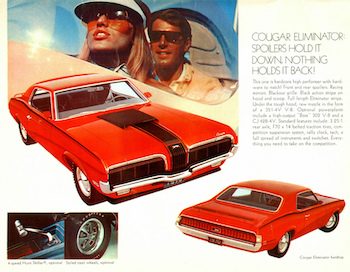
Advertisement for the Mercury Cougar Eliminator, of which just 4,518 were produced for the two years in 1969 and 1970. Today these cars are collector favorites and command top prices, especially the 428 Cobra Jet. (Ford)
Unfortunately, the 1970 Cougar was the last of the “real Cougars.” Mercury increased its wheelbase in 1971 an additional two inches from 111 to 113, thus ending Cougar’s “Pony Car” status. By1974, Cougar was a sister to the Torino / Montego line and then in 1977 shared platform time with the even larger Thunderbird.
Today, Cougars from 1967 to 1970 are all very collectible, especially the convertibles. Of the near 375,000 Cougars built in its four years of production, only about 13,500 were ragtops. The most collectible are the 428 Cobra Jets, the 427 GTE, and the Eliminator CJ models. However, even the mild mannered small V8s bring some nice dollars these days in good shape.
With thanks to Michael Banks of Portland, Oregon, who compiles data on Cougars for the Cougar Club of America and the Eliminator Registry and is also an Eliminator Cobra Jet owner.
The Eliminator Registry currently has about 1,100 Eliminators recorded of the 4,518 built. Some cars are known to have been destroyed, and others are only known by a VIN stamp on an engine block or a random document. However, Banks said he adds around 10 to 20 new VIN’s each year as cars are pulled out of garages and barns, or parts and documents turn up.
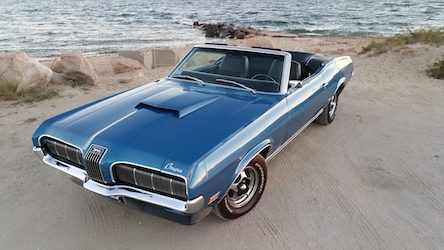
Photo of the gorgeous 1970 Cougar Eliminator owned by “Johnny Cougar” in New England is rare because it is a ragtop version. Very few Cougar convertibles with the big motors survived. (Johnny Cougar Collection)
Notable are the two incredibly special Cougars built in 1970 strictly for drag racing and powered by the Boss 429 Hemi Ford V8 for aforementioned “Dyno” Don and Mercury team driver “Fast Eddie” Schartman. These special Boss 429s began life as 428 Cobra Jets and were rebuilt to house the Boss 429.” Thus, they are counted in 428 Cobra Jet production numbers officially.
In 1970, the Cougar Eliminator would feature the new 351-V8 Cleveland engine as standard fare, featuring a canted valve design cylinder head similar to big-block Chevy. Rated at just 300-horsepower, the 351 Cleveland replaced the 390, which disappeared in 1970 on the Eliminator line. Also available was the Boss 302 and 428 Cobra Jet engine as Eliminator options.
While a lack of records existed in the past, the complete production number and breakdown by engine can now be found on the GT-E Registry page. To summarize, 394 GT-E’s were built, with 357 of those having the 427 side oiler engine, and 37 with the 428CJ engine. On the subject of rarity, only three of those GT-E’s were equipped with a 4-speed manual transmission. One of those 4-speeds sold at auction eight years ago for $228,800.
As for the Cougar Eliminators, updated production numbers include 2,250 Eliminators built in 1969, while in 1970 there were 2,268 built.
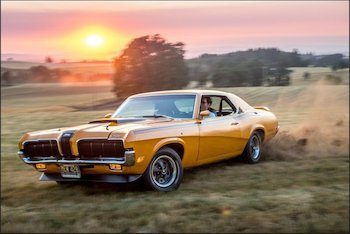
Reader Michael Banks does an Oregon farm field “little bitty broad slide” for the camera in his gorgeous 1970 Cougar Eliminator finished in Competition Gold with black décor interior. It is one of just 70 that came with the 428 Super Cobra Jet V8 with Ram-Air and a 4-speed transmission. Michael assists the Cougar registry with production number searches and updates. (Banks Collection)
As part of tracking / documenting Cougar Eliminators, the Eliminator Registry currently has about 1,100 Eliminators recorded, out of the 4,518 built. Some cars are known to have been destroyed, and others are only known by a VIN stamp on an engine block or a random document or newspaper advertisement. However, Banks noted he adds around 10 to 20 new VIN’s each year as cars are pulled out of garages and barns, or parts and documents turn up.
Thanks again Michael Banks, because I know from experience researching production figures is always difficult as there’s so much misinformation out there. Noteworthy, too, is a legendary gent by the name of “Johnny Cougar” who would read my column in the Cape Cod Times. He’s the proud owner of a special ordered 1970 Cougar 428SCJ Convertible that he bought new. His beauty is ultra rare (perhaps the only survivor of just three built) and he has no plans of parting with it. (See photo of Johnny’s spectacular Cougar.)
Finally there is Phil Jameison, also a Cape Cod Times reader, who also deserves a thanks for assisting in the Cougar production number tracking.
There you have it, fans, my Top 10 Muscle Cars of All Time. I hope you enjoyed the ride as much as I did.
(Greg Zyla is a syndicated weekly column and feature writer who welcomes your opinions, questions and views on collector cars, auto nostalgia and motorsports at greg@gregzyla.com or snail mail at Greg Zyla, Roosevelt St., Sayre, Pa. 18840.)

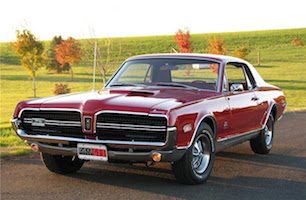
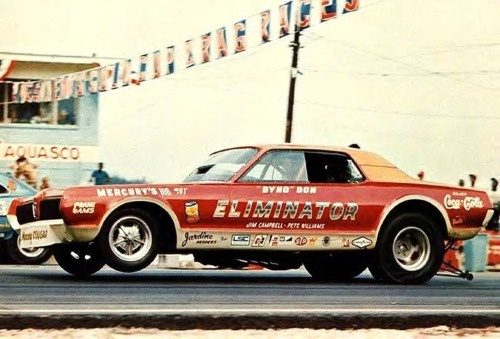

Be the first to comment on "Car Collector Corner; No. 10 of Top 10 Muscle Cars of All Time Series: 1968 to 1970 Mercury Cougar GTE/Eliminator"